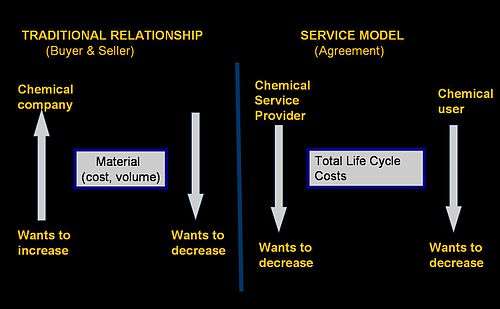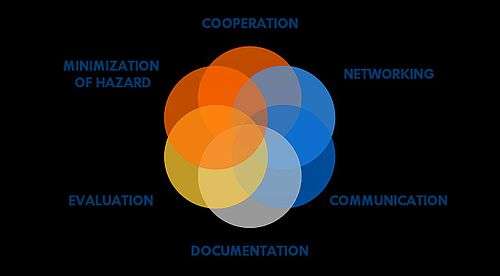Chemical leasing
Chemical Leasing is a business model that intends to shift the focus from increasing sales volume of chemicals towards a value-added approach.[1] It leads to the more efficient use of chemicals, and to the improved health and safety, environmental, and economic benefits. Find the definition and the examples on www.chemicalleasing.org
Definitions
The term Chemical Leasing is the name of a business model and is NOT the same thing as leasing of chemicals, although it may include leasing operations.[2]
The producer mainly sells the functions performed by the chemical and the functional units, such as the number of pieces painted, are the main basis for payment.[3] It is a business model in which a customer engages with a service provider in a strategic, long-term contract to supply and manage the customer's chemical and related services.[4]
Chemical Leasing applied in many companies, but sometimes under different names. Similar concepts: eco-efficient services, product-service systems, pay-per-use, circular economy, performance-based, functional-based, service-oriented, chemicals-as-a-service, etc. In case of the doubt, it is better to check the official UNIDO definition of Chemical Leasing:[5]
- Chemical Leasing is a service-oriented business model that shifts the focus from increasing sales volume of chemicals towards a value-added approach.
- The producer mainly sells the functions performed by the chemical and functional units are the main basis for payment.
- Within Chemical Leasing business models the responsibility of the user and the supplier is extended and may include management of the entire lifecycle.
- Chemical Leasing strives for a win-win situation. It aims at increasing the efficient use of chemicals while reducing the risks of chemicals and protecting human health. It improves the economic and environmental performance of participating companies and enhances their access to new markets.
- Key elements of successful Chemical Leasing business models are proper benefit sharing, high-quality standards and mutual trust between participating companies.

Chemical leasing promotes the sustainable management of chemicals. By shifting the focus from increasing the sales volume of chemicals towards a more value-added approach, it is an illustration of extended producer responsibility. The chemical company supplies chemicals for a specific service, such as coatings, adhesives, washing agents, solvents, and also advises the user on its best use.[6]
Built on strong cooperation between partners and based on mutual trust, it increases the efficient use of chemicals, reduces the risks to human health brought about by their use, improves the economic and environmental performance of participating companies and ultimately enhances business performance.[7]
Globalization
At the Earth Summit 2002 on sustainable development, the international community agreed on the goal of ensuring that, by the year 2020, chemicals will be produced and used in ways that minimize significant adverse impacts on human health and the environment. As a consequence the United Nations Environmental Programme (UNEP) decided to develop of the Strategic Approach to International Chemicals Management (SAICM) in 2003. In 2006 at the International Conference on Chemicals Management (ICCM) in Dubai, the signing countries committed themselves to promote the sound management of chemicals and hazardous wastes at all levels.
The Austrian government has played an important role in promoting chemicals management based on resource efficiency and precaution. When Austria held the Presidency of the European Union during the first half of 2006, chemicals policy was on top of the environmental agenda. Austria continues to promote chemical leasing.
The Federal Environment Agency (UBA) of Germany proposed to promote chemical leasing in its "Sustainable Chemicals" paper.[8]
UNIDO
In 2004, the United Nations Industrial Development Organization (UNIDO) and the Austrian Ministry of Environment decided to jointly support chemical leasing through a number of global projects. In partnership with National Cleaner Production Centers, UNIDO has implemented chemical leasing projects in Austria, Egypt, Mexico, and Russia. Since then, pilot projects have been conducted in Latin and South America, Africa, Europe and Asia. Nowadays, more than 100 companies worldwide have included Chemical Leasing in their business strategies.
Chemical Leasing can be applied in many industries and processes, ranging from car manufacturing to cleaning operations, wastewater treatment, textiles, beverage and food production. Some examples of the successful Chemical Leasing collaboration between the chemical user and the chemical supplier can be found here: http://chemicalleasing-toolkit.org/node/8
A Joint Declaration of Intent on Chemical Leasing was signed between UNIDO, Austria, Germany and Switzerland in November 2016.[9]
Examples
PERO Innovative Services GmbH together with SAFECHEM Europe GmbH, a subsidiary of The Dow Chemical Company, have supported Automobiltechnik Blau in metal cleaning to use cost-efficient machines, lower the energy consumption and chemical usage.
Akzo Nobel Powder Coatings S.A.E has supported the chemical leasing of powder coating in Egypt to ABB ARAB. Environmental benefits are said to include recycling of powder waste, compliance with environmental regulations, and enhancement of supply chain management.
Find more successful Chemical Leasing examples here: http://chemicalleasing-toolkit.org/node/8
REACH
The reversal of the burden of proof is a key component of the Registration, Evaluation, Authorisation and Restriction of Chemicals (REACH) system leading to a "no data – no market" concept, obliging producers or importers of substances to deliver documentation regarding properties of chemicals and possible risks during their application as a pre-condition for market access. The OECD Conference in Vienna in 2003 Nov. reiterated that, "... The new EU chemicals policy (REACH) will require a new relationship between provider and user ...." According to Thomas Jakl, Chairman of the European Chemical Agency (ECHA), chemical leasing paves the way to comply with REACH obligations.
Chemical leasing and REACH share the same philosophy of ensuring compliance with a duty of care (REACH recital 16), as a tool to demonstrate adequate control (REACH para 60). They are mutually supportive in developing rules for sharing costs, and ensuring that chemicals are handled properly. Both are involve several different stages of the supply chain. There is a strong effort by the Austrian and German Governments to bring chemical leasing within the purview of EU Chemicals policy and regulations.[10]
Project phases
Chemical leasing projects are divided into planning, implementation, evaluation and dissemination stages, based on a Deming Cycle. The planning stage consists of a preparatory phase, a process optimisation phase and a design phase. In this stage, discussions around the leasing model, its cost implications versus quality and environmental benefits, commercial terms, and conditions begin. A baseline audit is performed, and a report presented to the factory management. This audit outlines the potential for improvements and forms the basis of defining the key performance indicators (KPIs). The resources needed to fulfil improvements are also defined.
The implementation stage starts with the signing of a chemical leasing agreement that defines the scope and conditions, unit of payment, KPIs, roles, and responsibilities. The chemical company supervises the chemical process, transporting and managing the inventory, laboratory management, improving process controls, record keeping, and training workers. Periodic checks and inspections are carried out independently to verify that the implementation is proceeding on expected lines. At the end of the implementation phase, progress is evaluated, often by an external party to secure objectivity. Finally, any project benefits are quantified and learning is documented, to provide input for future projects.[10][11]
Global Chemical Leasing Award
16 January 2018 - The United Nations Industrial Development Organization announced the fourth Global Chemical Leasing Award. The award ceremony will take place on 6 November 2018 in Vienna, Austria. It will be part of the Green Chemistry Conference 2018 within the Trio Presidency of the Council of the European Union (EU) programme, “Smart and Sustainable Europe”, held during Austria's EU Presidency.
Companies and individuals are invited to submit applications for the award in three categories: case studies (for companies), research, and special innovation. The call for applications is open until 15 August 2018. More information can be found at www.chemicalleasing.org
The Global Chemical Leasing Award has been launched in 2010. The Award intends to further enhance the global visibility of Chemical Leasing, acknowledge best practices and inspire companies and individuals around the globe to apply the Chemical Leasing business concept by reducing the inefficient use and over-consumption of chemicals and developing strong business partnerships and innovation along the entire supply chain.</ref> The awards took place in 2010 (Prague), in 2012 (Frankfurt-am-Main), and in 2014 (Vienna).
References
- United Nations Industrial Development Organization
- "Chemical Leasing" vs leasing of chemicals, Vojislavka Satric and Maria Grineva, (LinkedIn, 2018).
- Chemical Leasing Goes Global – Selling Services Instead of Barrels: A Win-Win Business Model for Environment and Industry, Eds Thomas Jakl and Petra Schwager, (Wien : Springer – Verlag, 2008).
- M Stoughton, T Votta, Implementing service-based chemical procurement: Lessons and results. Journal of Cleaner Production 11(8) (2003) 839– 849.
- Chemical Leasing website
- Anurag Priyadarshi, The Colourist, 1 (4) (2009) 8
- Chemical Leasing Unburdens Environment – UBA presents sustainable chemicals concept, UBA Press Release 14 (Umwelt Bundes Amt, Germany, 2009).
- "Joint Declaration of Intent on Chemical Leasing signed between UNIDO, Austria, Germany and Switzerland".
- Chemical Leasing Goes Global – Selling Services Instead of Barrels: A Win-Win Business Model for Environment and Industry, Eds T Jakl and P Schwager, (Wien : Springer – Verlag, 2008).
- Anurag Priyadarshi, Chemical Leasing in Colour and Environmental Management – theoretical framework, implementation methodology and future outlook, paper read at UNIDO – GCPC Chemical Leasing workshop, 2009.
Further reading
- Jakl T, Joas R, Schott R, Windsperger A (2004), Chemical Leasing: an intelligent and integrated business model with a view to sustainable development in materials management, Springer, Vienna
- Jakl T, Schwager P (2008) "Chemical Leasing goes global – selling services instead of barrels: A Win-Win model for Environment and Industry." Springer Wien New York
- Jakl T, and Schwager P (2011) "Global Chemical Leasing Award 2010", Technology and Investment, 2011, 2, 20-26; Scientific Research
- United Nations Industrial Development Organization (2016) "Global Promotion And Implementation Of Chemical Leasing Business Models In Industry"
- Vojislavka Satiric, Maria Grineva,"Chemical Leasing - The Solution to Managing Chemicals Sustainably: 12 Things You Need to Know" (2018)(LinkedIn
External links
- Strategic Approach to International Chemicals Management
- United Nations Industrial Development Organization - Cleaner Production Programme
- Chemical leasing at the United Nations Industrial Development Organization
- Chemical Leasing
